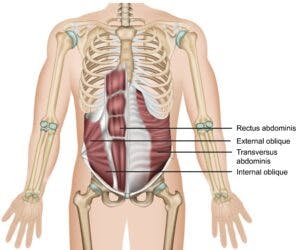Abdominal muscle weakness and poor control of your trunk (or “core”) negatively influence athletic performance and your activities of daily living. Poor trunk muscle strength is associated with injuries in baseball players and several other sports. Also, exercises to improve trunk muscle strength improve soccer and distance running performance. Trunk muscle weakness is also linked to falls in older adults and lower back pain in adults and children. This article shows you 6 of the best abdominal exercises.
How to Integrate Abdominal Exercises into Your Program

Abdominal exercises to improve the coordination of your trunk muscles should be integrated into a comprehensive total-body strength training program.
Training should never focus on any single muscle or body part. In general, abdominal exercises start in supported positions, like lying on your back, and progress to more functional positions, like standing.
Abdominal exercises target muscular endurance with short, sustained holds (8 to 10 seconds). As these exercises become easier, increase the number of reps you perform. Or the exercise itself can be progressed to a more challenging position. The 5 exercises below are ordered from the most basic to the most challenging. Start with the easier ones and work up to those that are more challenging.
Dead Bugs
Start on your back with your arms held straight up. Lift your feet off the floor. Bend your hips and knees to 90 degrees. Gently flatten your low back to the floor and maintain this abdominal contraction throughout the exercise. Simultaneously raise your right arm overhead and extend your left leg without touching down. Hold this position for several seconds and maintain low back contact with the floor.
Reverse the movement back to the starting position. Then, perform the opposite diagonal pattern with the left arm and right leg. Alternate sides with each repetition. Maintain low back contact with the floor throughout the exercise. Perform 8 to 12 repetitions on each side. Do 2 to 3 sets several times per week.
Stability Ball Roll-Outs
Begin in a tall-kneeling position with both your hands on the ball. Roll your hands along with the ball until your elbows or upper arm contact the ball. Your elbows should remain extended as your hands and hips move together.
Engaging your glutes and abdominal muscles helps maintain proper position during the exercise. As you lower your body towards the floor, maintain a neutral spine and avoid arching your low back. Hold this position for several seconds before reversing the movement back to the starting position.
Perform 8 to 12 repetitions on each side. Do 2 to 3 sets several times per week.
Side Plank with Rotation
Begin in a side-lying position, resting on one elbow. Raise your trunk and knees off the floor. Fully support yourself on one elbow and both feet. While maintaining the side plank position, reach up and then under and behind your body with the top hand. This will cause some trunk rotation and challenge your oblique abdominal muscles.
Hold this position for several seconds before reversing the movement back to the starting position. Perform 8 to 10 repetitions on each side. Do 2 to 3 sets several times per week.
Half-Kneeling Cable Chop
Get in a half-kneeling position next to a cable column or anchored resistance band. The kneeling position removes contributions from your lower body and increases the demands on your trunk, pelvis, and hips.
From a balanced and upright kneeling position, pull the cable or band diagonally across your body towards your opposite hip. Maintain a neutral spine and trunk position throughout the exercise. Avoid rotating your body as your arms pull across your body. Resisting this movement is what activates your abdominal muscles.
Hold this position for several seconds before reversing the movement back to the starting position. Perform 8 to 12 repetitions on each side. Do 2 to 3 sets several times per week.
Lateral Lunge with Press and Reach
This advanced exercise starts from a standing position next to a cable column or anchored resistance band. Holding the handle or band close to the body, initiate the exercise with a lateral lunge.
Next, slowly press your arms straight out in front of your body. The band or weight causes a rotational challenge to your trunk muscles. Resisting this movement is what activates your abdominal muscles.
Finally, slowly raise your arms straight overhead while maintaining the lunge position. Maintain a neutral spine and trunk. Hold this position for several seconds before reversing the movement sequentially back to the starting position. Perform 8 to 10 repetitions on each side. Do 2 to 3 sets several times per week.
Get Some Help Starting an Abdominal Exercise Program
Abdominal exercises are 1 component of a comprehensive exercise program targeting total body strength and performance. Abdominal exercises performed in isolation are rarely successful in improving performance or decreasing lower back pain. When developing your program, consider these 5 trunk muscle exercises. Performing each exercise in a controlled fashion, with a focus on proper technique and endurance, will get you the best results in the long term.
If you are having difficulty getting started, contact your physical therapist today. Take the first step and schedule your initial evaluation. The physical therapists at BSR have been helping the people of Southern Ocean County move without pain since 2007. We would love to help you achieve your goals.


